Q3 2022

About the initiative
News trends takes a quantitative approach to understanding the stories and publications that are driving coverage of China. The data is based on the stories that appear during daily queries on Google News for the term “China.” Google News is an important aggregator and, for many publishers, it and the Google search engine account for the plurality of their web traffic. Thus, the stories that Google News elevates plays an important role in shaping popular understanding of China.
Previous months
Q2 2022
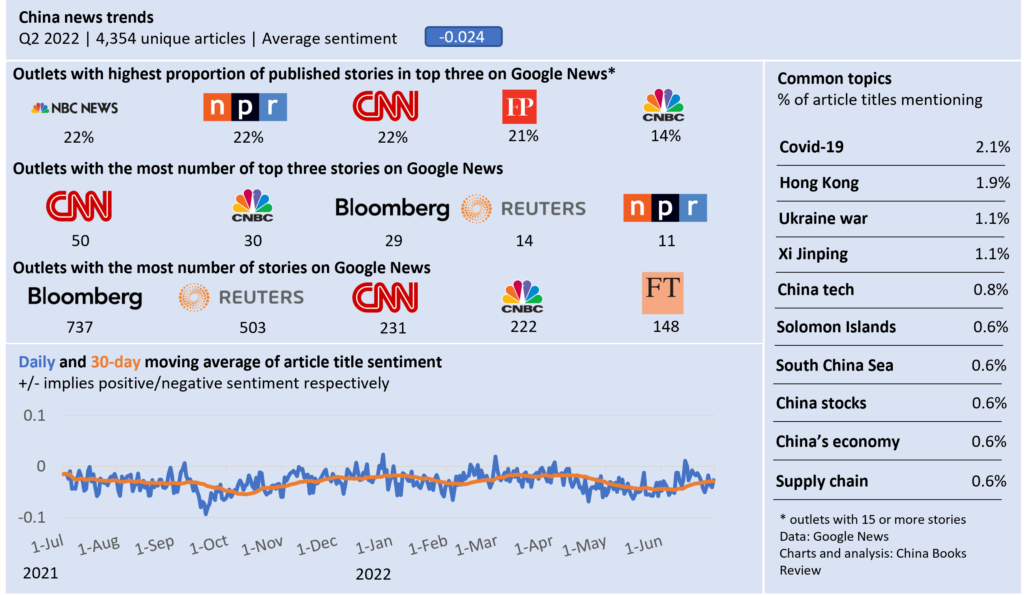
Q1 2022
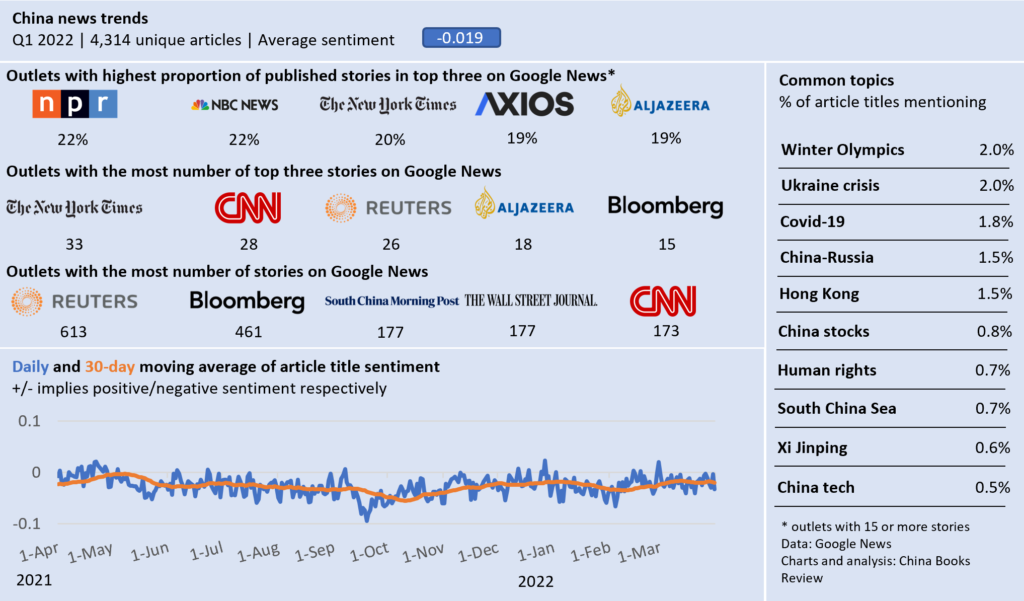
In the first quarter of 2022, NPR had the highest proportion of its stories place in one of Google News’ top three positions. The New York Times had the most number of top three stories and Reuters published the most stories overall. The stories with the longest duration on the platform, a measure of impact, included Times stories on Taiwan’s hardening separate identity; the unintended consequences of an anti-graft show; the impacts of coronavirus border restrictions on Southeast Asian fruit farmers; and an NPR story on China’s influence in Southeast Asia.
Q4 2021

CNN had the highest proportion of published stories among Google’s top three during the period as well as the most number of top three stories overall. Reuters published the most stories overall. The longest running stories included a CNN report on a resurgence in coal mining, an Atlantic article on how China was driving democracies to support of Taiwan, and a New York Times report on Xi’s months-long abstinence from foreign travel.
Q3 2021

Sentiment of news coverage related to China reached year-lows in the third quarter of 2021, as reporting on the coronavirus, Hong Kong, and the crackdown on Chinese tech companies grabbed the headlines. CNN maintained its lead of outlets with the number of top three stories on Google News and the highest proportion of its articles be so ranked. Reuters remained the leading publisher of stories overall during the period. The longest running stories, a measure of their significance, included CNN coverage of China’s regulatory storm and investors’ reactions, the Delta variant’s disruption to the economy, and the New York Times on “why Biden seems worse to China than Trump.”
Q2 2021
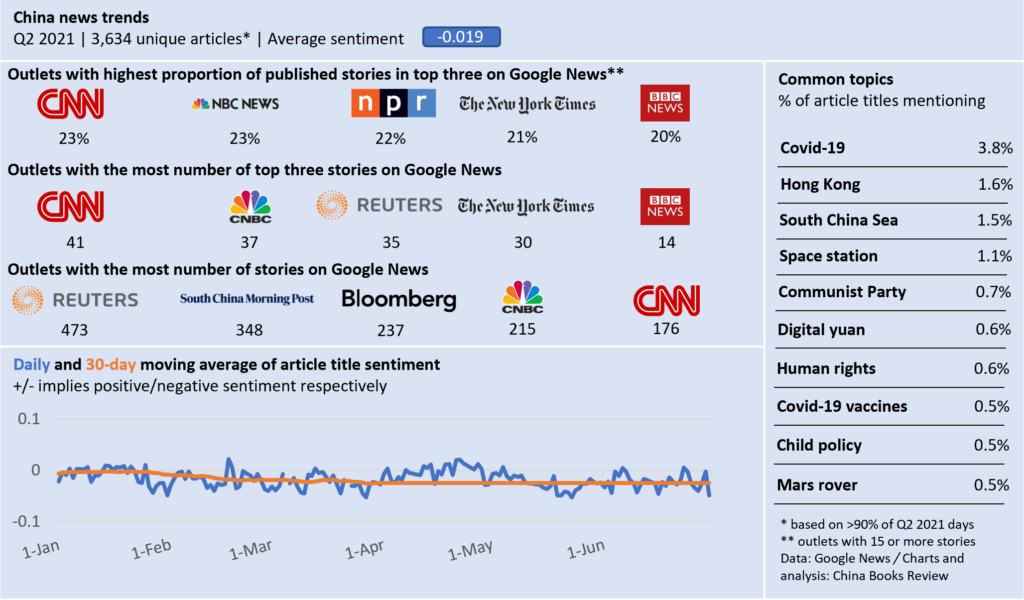
In the second quarter of 2021, the coronavirus and Hong Kong continued to lead China coverage while China’s space program, including its Mars rover and space station, also shot to prominence. CNN led outlets with the highest number of top three stories on Google News and the highest proportion of its articles be so ranked. Reuters published the most stories on China during the period. The longest running stories during the period, a measure of their significance, included New York Times reports on China’s internet antitrust push and global propaganda efforts, BBC coverage of US Secretary of State Antony Blinken’s claim that China was acting “more aggressively,” and a CNN report on the hundredth anniversary of the Communist Party’s founding.
Q1 2021
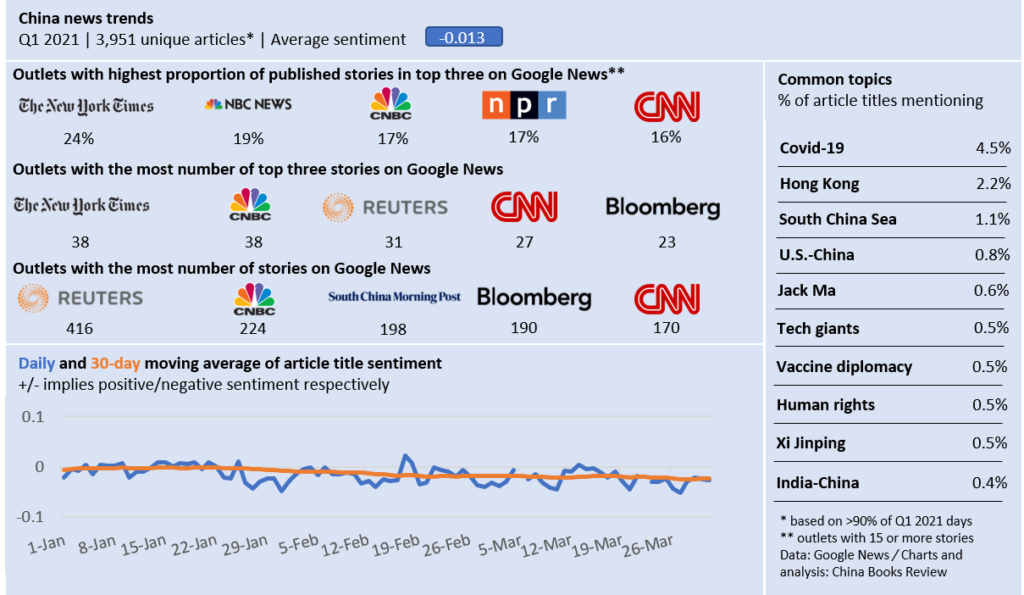
In the first quarter of 2021, the coronavirus and Beijing’s campaign to eliminate dissent in Hong Kong were the leading stories. The New York Times led with the most number of top three stories and with the highest proportion of top three stories as a share of total stories it published during the period. Reuters led with the most number of China-related stories published overall. The longest-running stories during the period, a measure of their significance, were all published by the New York Times, covering China’s economic recovery, the political implications of a stronger renminbi, and rules aimed at countering U.S. sanctions.
2020

In 2020, the coronavirus and Hong Kong led news coverage of China. Sentiment of article titles was negative for 79% of the days captured by the analysis. CNBC, the New York Times, and CNN published the most number of China-related stories indexed by Google News and had the highest number of stories achieve a top three position on the aggregator. As a proportion of stories published that were a top three story on Google News, NBC News, Al-Jazeera, and Politico led.
December

In December, stories on China’s stock market and its successful lunar space mission were among the most commonly reported. The stories with the longest staying power included an NPR report on China’s delivery workers, China’s declaration that it had eliminated absolute poverty, a tightening of US visa rules for CCP members, and a look at AstraZeneca’s scandal-prone Chinese partner.
November 2020

In November, the Financial Times joined the ranking of most cited publishers on Google News for the first time since News trends began. New York Times stories occupied Google News’ top three positions most frequently during the month. The stories with the longest staying power were an NPR interview on Taiwan; CNN coverage of a coronavirus outbreak in Xinjiang; and Times reports on Chinese views on homosexuality and the World Health Organization’s deference to China in identifying the source of the coronavirus.
October 2020

For the first time since China Books Review began its news analysis, the overall sentiment of stories published on China for the month was positive, driven by China’s economic recovery. CNBC and CNN led with the most China-related stories during October. The longest-running stories were a CNN story on protests in London related to China’s treatment of its Uyghur minority; a CNBC story on Chinese tech companies; a Wall Street Journal report on the country’s economic gains; and a New York Times write-up on China’s car market.
September 2020

In September, the longest-running stories were a CNN story on a former Communist Party insider who now criticizes its direction and New York Times reports on China’s surging exports, WeChat, and the behavior of local officials in the early days of the coronavirus outbreak. CNN and the Times published the most stories aggregated by Google News; CNN had the most top three stories of any outlet.
August 2020

In August, CNN, CNBC and the New York Times controlled more than half of the top three places on Google News. The longest-running stories included BBC News reports on life as a Chinese student in the United States and the internment of the Uighur population; a New York Times story on China’s reliance on construction to revitalize its economy; and a Pew Research Center study on Americans’ declining sentiment towards China.
July 2020

Google News’ algorithm appeared to boost BBC News and The Wall Street Journal for the first time since News trends began, each among the organizations with the most top-three stories. The longest-running stories during the period captured included a New York Times feature on China’s nuclear weapons build-up; a Foreign Policy op-ed on China’s fiscal constraints; CNN stories on how coronavirus has upended the CCP’s poverty alleviation targets and the country’s historical fears of separatism; and a BBC report on measures imposed to prevent a flare-up of the COVID-19 in Hebei province.
June 2020

Coverage of Hong Kong’s national security law and the coronavirus were June’s major China stories. CNN reporting on China’s defense budget and “wolf warrior” diplomacy were among the longest-running stories of the month, alongside New York Times coverage of a US-China dispute over reciprocal airline access. At the half-way mark of the year, the New York Times leads in terms of the total number of stories on China published and the total number of stories occupying a top three position on Google News. Al-Jazeera, Politico, and CNN have the highest proportion of stories published which achieve a top three position.
May 2020

The New York Times, CNBC, and CNN captured 57% of the top three daily stories on Google News about China throughout the month of May. Coverage of Hong Kong surged as Beijing unilaterally imposed a national security law that opponents feared marked the effective end of the city’s autonomy. The longest-running stories in May included Washington Post reporting on the Trump administration’s moves to retaliate against China for its role in the global coronavirus outbreak; New York Times reporting on the coronavirus’ impact on China’s economy and international standing; and CNN coverage of how China’s authoritarian political model is winning adherents in some parts of the world.
April 2020

The coronavirus continued to dominate China news coverage. The month’s longest-running stories were New York Times reports on China’s failed containment of the virus; the American intelligence community’s doubts about the accuracy of China’s virus reporting; and how hundreds of thousands have traveled from China to the United States despite travel restrictions. An essay in The Atlantic warning against a premature return to normalcy was also among the month’s key stories. The Guardian and Fox News were among the most prolific publishers on China for the first time since the news trends initiative began.
March 2020

The globalization of the coronavirus outbreak, with the worst appearing to be behind China, was the focus of March’s news. The New York Times continued to lead with the most stories indexed by and featured in Google News’ top three stories. The month’s longest-running articles involved China’s deployment of technology to enhance its surveillance and control of the outbreak; an examination of why China’s measures to control the outbreak may not succeed in other countries; and articles capturing how Beijing’s propaganda is being received abroad and at home.
February 2020

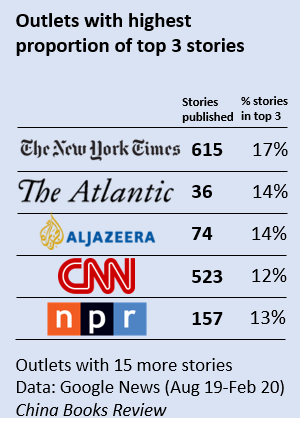
The coronavirus continued to drive headlines in February. The New York Times led outlets in the volume of stories published and the share of top three articles during the month. The month’s longest-running stories were focused on the international dimensions of the outbreak, its political implications for Xi Jinping, and the anti-Chinese sentiment the virus has inflamed. Tracking articles captured by Google News since August 2019, the Times leads with the highest proportion of articles achieving a top three position on the news aggregator.
January 2020

The coronavirus drove a marked decline in headline sentiment in January. The New York Times led outlets in the volume of stories published and the share of top three articles during the month. The South China Morning Post was among the top five most prolific publishers for the second straight month but had few stories among Google News’ top three. The longest-running stories for the month included a 2019 retrospective by Foreign Policy and New York Times articles on the sentencing of the scientist who genetically edited babies, pickup artists, and the separation of hundreds of thousands of Uighur children from their families.
December 2019

The South China Morning Post was among the top five publishers of China-related content as aggregated by Google News for the first time since News trends began last summer. It, and Bloomberg, however never had a story featured in a top three position during the month. The longest-running stories for the month were a CNN report on facial recognition; New York Times on China’s relations with Taiwan and Australia; and Fareed Zakaria’s essay questioning the more hawkish shift in American thinking on China.
November 2019

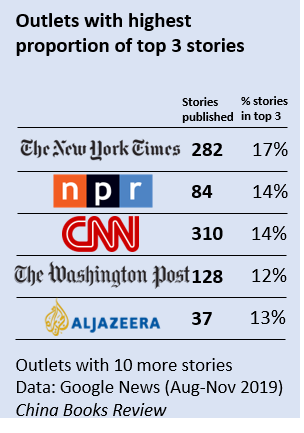
Hong Kong and trade talks remained the most common topics of China-related news coverage in November as reflected by Google News. CNBC remained the most prolific source of coverage and occupied a top three story position 20% of the time. A separate analysis, spanning August to November, finds that the New York Times has the highest proportion of its stories that land in a top three position, at 17%, followed by NPR and CNN. The longest-running stories for the month were a CNN report on the Central Committee meeting; and three New York Times stories, including a report on social media platform TikTok, China’s trade policy, and Xi Jinping’s political health.
October 2019

Some optimism creeped into coverage of China in October, as “trade deal” joined “trade war” as one of the most common topics. CNBC remained the most prolific source of coverage and matched the New York Times in occupying 19% of the month’s daily top three story positions. Bloomberg, the second most prolific publisher of China-related stories, had just a 1% share of top stories; the Wall Street Journal and Washington Post led the news 6% and 5% of the time. The longest-running stories for the month were a CNN feature on the seventieth anniversary of the People’s Republic, an NPR story on economic inequality, and two New York Times stories, one on Trump’s blacklisting of several Chinese tech companies, nominally for abetting human rights violations in Xinjiang, and another on Hong Kong’s protests.
September 2019

Stories about the trade war and Hong Kong protests continued to lead China-focused coverage in September, according to a China Books Review analysis of Google News data. CNBC remained the most prolific publisher of stories about the country and this month led with the most number of stories in the top three positions of Google News results. The stories that were featured for the most number of days included a look at how Hong Kong’s relationship with the mainland has evolved; reporting on how China justifies its oppressive tactics in Xinjiang to other Chinese; and two stories on China’s economy, one refracted through the lens of US politics.
August 2019

Hong Kong was the most frequent topic of articles aggregated by Google News related to China in August, according to a quantitative news analysis by China Books Review. In August, the data set included 1,575 unique articles from some 200 publications. Article titles mentioning Hong Kong constituted 10% of those aggregated, closely followed by the trade war. In August, a Washington Post analysis of Xi Jinping’s hold on power appeared for 22 days, followed by a report from Science on the alarm among Chinese scientists triggered by increasing US government scrutiny of research relationships with China. CNBC was the most prolific publisher with 178 articles; the top five most prolific publishers accounted for more than 30% of the total articles aggregated. Stories from the New York Times appeared in the top three results 17% of the time, followed by CNN at 16%.